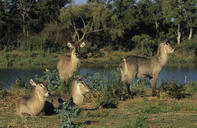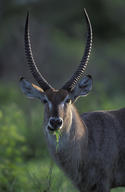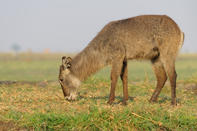Why the White Ring?

The waterbuck is best recognized by the white ring around its rump. This has lead to its Afrikaans colloquial name of ‘kringgat’ meaning ‘circle-bottom’.
The white ring is a ‘follow me’ sign. Waterbuck females and young live in herds and when startled will flee, often into the water. The white ring induces animals in the group to follow each other and as altruistic as this may seem, it, in fact, serves to buffer the individual from danger.
By having an animal ahead and one behind, the individual is spared attack from either direction. Obviously, the white ring has benefit for the young that thus have a beacon to follow when running behind their mothers to escape danger.
Odour

Waterbuck have glands in their skin that release a musky odour. Territorial bulls are particularly smelly and the aroma can be detected up to 500 m away from the animal.
It is not known what this gland is for but suggestions have been made to the effect of the glands being related to waterproofing their shaggy coats for their water-loving lifestyles.
It is untrue that these glands make the animals immune to predation by crocodiles and lions as waterbuck are preyed on by all medium to large sized predators. Even humans can eat waterbuck meat but the skin must be carefully pulled away from the flesh to prevent tainting.
Unique Calves

Waterbuck calves are unique amongst antelope in that they are relatively mobile during their lying up period, a period of 2 - 4 weeks just after birth during which time they remain hidden apart from the herd.
After each visit from the mother to feed, the calves find their own hiding place under bushes but when threatened, they will often flee from the threat rather than lying still and trying to remain undetected. They are very vulnerable at this stage in their lives.
By Megan Emmett